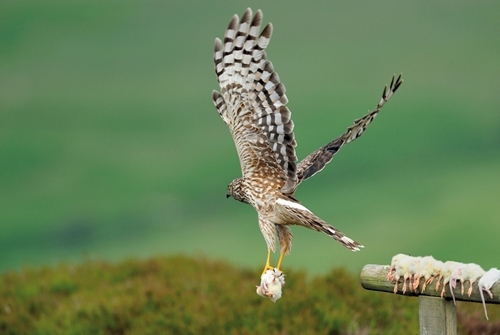In England, one conservation problem that has proved more intractable than most is identifying how we can begin to sustainably rebuild hen harrier populations alongside driven grouse shooting. To this end, in August 2012, Defra officials established the Hen Harrier Sub-Group of the Uplands Stakeholder Forum including representatives from Natural England, the Moorland Association, the National Gamekeepers’ Organisation, the GWCT, the National Park Authority and the RSPB. After several delays, the Joint Action Plan to Increase the English Hen Harrier Population was published in January 2016.
The plan recognises that if we want viable grouse shooting alongside hen harriers, we will need new kinds of management. Conservation techniques such as diversionary feeding and brood management will be required to resolve the genuine conflict between red grouse and hen harriers.

The Joint Recovery Plan proposes diversionary feeding to reduce
hen harrier predation of grouse chicks. (Photo © Laurie Campbell)
| What is in the Joint Recovery Plan? |
- Law enforcement, prevention and
intelligence
- Ongoing monitoring of breeding sites
and winter roost sites
- Further research of the movement of
hen harriers using satellite tracking
- Diversionary feeding of hen harriers
to reduce predation on grouse chicks
- Engagement study about reintroducing
them across suitable habitat in England
(e.g. translocation of French lowland
harriers to our lowlands)
- Trial the temporary movement of hen
harrier young to aviaries (also called
‘brood management’)
|
That conflict was illustrated on a driven grouse moor at Langholm between 1992 and 1997. Hen harrier numbers rose from two to 20 pairs in six years, before shooting was then abandoned because the hen harriers ate over a third of all grouse chicks that hatched. With no grouse shooting, the local culture, economy and employment suffered and the control of generalist predators ceased. By 2003, the 20 harrier nests were back down to two and numbers of breeding grouse and waders had more than halved. Predation was identified as the most likely cause of the declines for grouse, waders and harriers. Grouse moor managers felt their worst fears had just been proven – this was a real lose/lose situation.
More recent evidence from the Langholm Moor Demonstration Project (a partnership between the GWCT, Scottish Natural Heritage, Buccleuch Estates, the RSPB and Natural England) has shown that diversionary feeding can reduce predation when harrier numbers are low and their nest easily accessible, but more research is required since, alone, it has not been shown to increase numbers of young grouse.
To overcome the root causes of the harrier-grouse conflict, any new recovery plan would need to ensure both hen harriers and grouse populations can thrive. Now, after 15 years of talks, 20 reports, three governments and six years of mediated conflict resolution talks, a plan to increase the hen harrier population has been published and is available on the Defra website.
How does brood management work?
Nesting hen harriers can take significant numbers of grouse to feed their own chicks. Should a harrier build a nest within 10km of another, the harrier chicks in the second nest would be temporarily removed to reduce pressure on the grouse population. Any harrier chicks temporarily removed to aviaries would be released back to suitable habitat once fledged. This has not yet been trialled in the UK but has been successfully demonstrated in France, where lowland hen harriers nest in cereal crops.
Brood management is an approach that can both boost the hen harrier population and give keepers the confidence to allow hen harriers to settle on driven grouse moors.